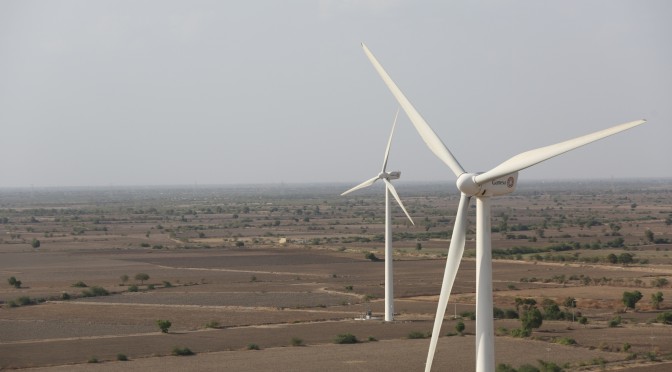India is the fifth largest producer and consumer of electricity after the US, China, Japan and Russia. But our per capita consumption (957 kWh) is among the lowest. China’s is 4,000 kWh, while in developed countries it is close to 15,000 kWh. India needs faster economic growth for improving quality of life and increasing opportunities for development. As of May, 19,706 villages did not have access to power and about 700 million people use biomass as their primary energy resource for cooking. With such poor access to electricity, India needs to ensure a balance between electricity supply and reducing emissions. Harnessing clean energy through renewable sources is thus an essential requirement. Even as there was renewed focus on clean energy at the recent climate talks in Lima, many challenges deter expansion of renewable energy sources to meet the required goals.
The last few years have seen an increasing thrust—both from government and private players—on renewable energy generation. While the total estimated medium-term potential (2032) for power generation from renewable energy sources is about 183,000 MW, the Twelfth and Thirteenth Five Year Plans have envisaged an additional capacity of 18,500 MW and 30,500 MW. The government has been promoting renewable energy through tax and non-tax incentives. But there are hurdles, ranging from lack of grid parity, inadequate infrastructure to payment security of supply by beneficiary discoms.
India has abundant renewable energy sources—total renewable installed power as of April 2015 exceeded 35 GW. Of that, wind energy accounts for 66% (23 MW), followed by small hydropower (4 GW) and solar power (3.7 GW). Renewable energy also contributes to 13% of the total power generated in India. The current potential is far from being exploited and a lot more can be anticipated as all stakeholders come together towards clean energy generation.
India now ranks fifth amongst the world’s top ten wind power producers, by adding 1,700 MW in 2013. With the current installation of 23 GW, the estimated potential has been revised to 103 GW from the earlier 48 GW. New advanced analysis models and techniques are being undertaken to identify new windy sites and optimise wind farm efficiency.
The government plans to launch the National Wind Energy Mission in the near term. While the details are not known yet, it could significantly boost India’s wind energy capacity. According to the Global Wind Energy Council, the installed wind energy capacity could reach 83 GW by 2030 under the existing policy and can surpass 150 GW if more ambitious policies are implemented.
The ministry of new and renewable energy has also drafted the National Offshore Wind Energy Policy to promote deployment of offshore wind farms up to 12 nautical miles from the coast. Gujarat is expected to see the first demonstration project of a 100 MW offshore plant. Considering that India has a 7,600-km long coastline, offshore opportunities for scaling up are good.
The big challenge for wind power is the need for large tracts of contiguous land. Land acquisition is getting difficult, especially if you need to be close to the evacuation point. In view of the short gestation period, transmission has to lead generation and would require upfront investment. The other issue is grid connectivity as wind sites are far from urban centres. Capital-intensive technologies such as offshore wind technology need special infrastructure like turbine installation vessels, construction support vessels and heavily insulated submarines for installation.
The technical challenge is the variability of wind power which affects load generation balance, varying demand for reactive power and impact on voltage stability. The CERC has introduced a renewable regulatory fund mechanism by which all wind generators with a collective capacity of 10 MW and above are required to participate in scheduling and forecasting power generation on a day-ahead basis. This will help factor variability and improve grid operation.
The domestic grid suffers due to lack of adequate infrastructure for transmission and distribution. Then there are AT&C losses, which reduce efficiency. The adoption of automation and monitoring systems in transmission and distribution can increase operational efficiency of the grid by reducing downtime with improved coordination and remotely controlled devices alongside integrating distributed generation.
India is on the way to energy ‘leapfrogging’. This strategy allows developing countries to move from relying on fossil fuels in energy development to a new path incorporating advanced energy technologies. With the current need for power coupled with the need for meeting emission reduction targets, it is imperative to increase the fuel mix in the country. As turbine capacity rises, wind is going to be huge contributor to the power sector in the coming years.
The private sector is investing in a big way in the sector. Tata Power too is committed to add to India’s portfolio of wind power. The current installed wind power capacity of the company has crossed 500 MW and is among the leading wind power generators today.
It would be equally important for utilities in India and authorities responsible for development and sustenance of wind power to ensure the capability to maintain, retrofit, re-power and re-engineer critical components to bring longevity to the wind turbine generators and associated components as also to harness the best possible efficiencies in the locations that are utilised for the generation of wind energy.
By Anil Sardana
The author is MD & CEO, Tata Power.


